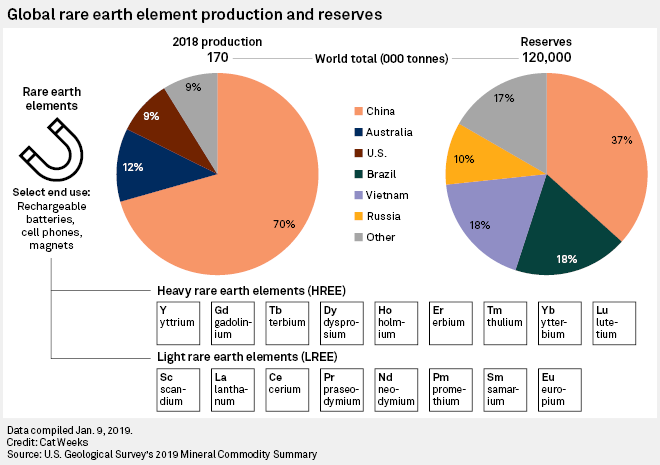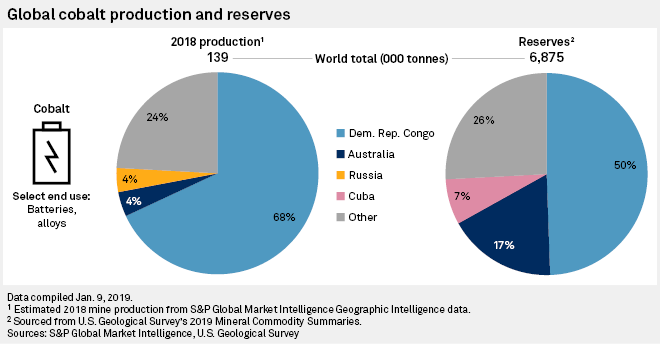The U.S. still has a long way to go to minimize its dependence on China as it works to diversify its critical minerals supply chain, according to industry observers from the U.S. and Australia.
In 2019, the U.S. signed a memorandum of understanding with Australia to increase both countries' capacity for critical minerals, given rising demand from the clean energy sector. And in 2018, President Donald Trump's executive order 13817 finalized a list of 35 minerals deemed critical for the national economy and defense.
That MOU was the first to emerge from the Energy Resources Governance Initiative, a multilateral effort the U.S. Department of State's Bureau of Energy Resources started in 2019 to engage with other countries. The U.S. has since signed a similar memorandum with Canada regarding energy mineral resources.
Companies and experts in Australia and the U.S. suggested in recent interviews that the MOU is an early step in tackling larger challenges to building a diverse supply chain.
The MOU with Australia is still in its "infancy" in terms of effects, Tom Crafford, program coordinator for the U.S. Geological Survey's Mineral Resources Program, said in a Jan. 10 interview.
The USGS already had its own MOUs in place to allow for information sharing with Australia, Crafford said, noting that mining contributes more to the Australian and Canadian economies than to the U.S. economy.
"They're two of the largest mining countries in the world," Crafford said. "And it's really to, I think, our national advantage when it comes to critical minerals to have this close relationship with those countries."
Australia's potential
Though Australia is a major producer with significant reserves of certain rare earths, China dominates the downstream services and supply chain.
Matt Canavan, Australia's minister for resources and northern Australia, told attendees at a November 2019 Atlantic Council event that Australia's resources can help supply 28 of the 35 critical minerals, up from a prior assessment of 14, including lithium, cobalt and rare earths.
Australia was the second-largest producer of rare earths in 2018, with 12% of global production. It trailed China, which had 70.6% of global production and 36.7% of global reserves, according to the latest USGS figures.
 |
Even if the U.S. could source an alternative supply of critical minerals from other countries, it would still need to consider investing in domestic processing and manufacturing to compete with China.
Pini Althaus, CEO of New York-based USA Rare Earth LLC, announced in December 2019 the development of a rare earth-processing pilot facility in Wheat Ridge, Colo. The facility is scheduled to begin production in 2023 and will process minerals sourced from the company's 80%-owned Round Top project in El Paso, Texas. Round Top is unique for hosting 15 of the 17 rare earths, in addition to lithium.
Althaus said that aside from the pilot facility, "there really is no real processing alternative outside of China." While miners can potentially source raw materials from non-Chinese suppliers, there is no processing capability for rare earths in the U.S. Althaus noted a turning point in terms of demand with efforts by the Pentagon to focus on domestic sources.
Australia's cobalt, lithium supply
Australia has some of the largest reserves and is a top producer of cobalt, based on 2018 figures, but the nation still falls far behind the Democratic Republic of Congo on both fronts. Australian mining companies also said the supply chain inevitably involves China at this point.
 |
Sean Gregory, CEO of cobalt hopeful Barra Resources Ltd., said in a recent interview that while "it's all well and good" for governments and automakers to highlight critical mineral supply issues, such groups need to "put their money where their mouth is" and reach further down the supply chain than usual to source sustainable cobalt.
While established non-China downstream industries for cobalt and lithium exist in the U.S. and Europe, Gregory said Western Australia's mining industry has a long history of successful business partnerships with China, Japan and South Korea. Thus, given Barra's board is tasked with creating value for shareholders, the development partners for its Western Australian Mt Thirsty project will most likely be Asian, though Gregory said he would welcome a U.S. company's approach.
Australia is a top producer of lithium, but China still maintains a hand in processing and downstream services. Lithium Australia NL Managing Director Adrian Griffin said China's "total domination" of lithium's supply chain is slowly undergoing a structural change due to rapid market expansion, and the company is trying to establish downstream operations outside China.
 |
Australia has an advantage over other countries from which the U.S. can source rare earths due to its geology, according to George Bauk, CEO of Western Australian heavy rare earths producer Northern Minerals Ltd. The state hosts one of the world's best light rare earths projects in Lynas Corp. Ltd.'s Mt Weld mine, not only by grade but due to its advanced status.
Challenges ahead
The memorandum may serve as a template for similar agreements with other countries, experts said. David Livingston, deputy director of the Atlantic Council's Global Energy Center, a Washington-based think tank, said in an interview that it is probably too early to decipher all implications of the agreement. But Livingston noted that the two partners have high standards for their mining sectors and are seeking investment in the space.
"The question is whether the MOU and the nature of agreements go far enough to encourage the market certainty and the demand certainty and supply agreements that will unlock additional financing," Livingston said. "I am not yet convinced of that, so I think it's still early days."
Reed Blakemore, an associate director with the Global Energy Center, said the Trump administration is trying to build demand in the U.S. that is interested in paying for the "dolphin-free tuna version" of mined materials, a premium to ensure the materials are mined sustainably.
"In the process of doing that, you raise the floor of necessary capital into those projects such that you can't get undercut by China," Blakemore said.



